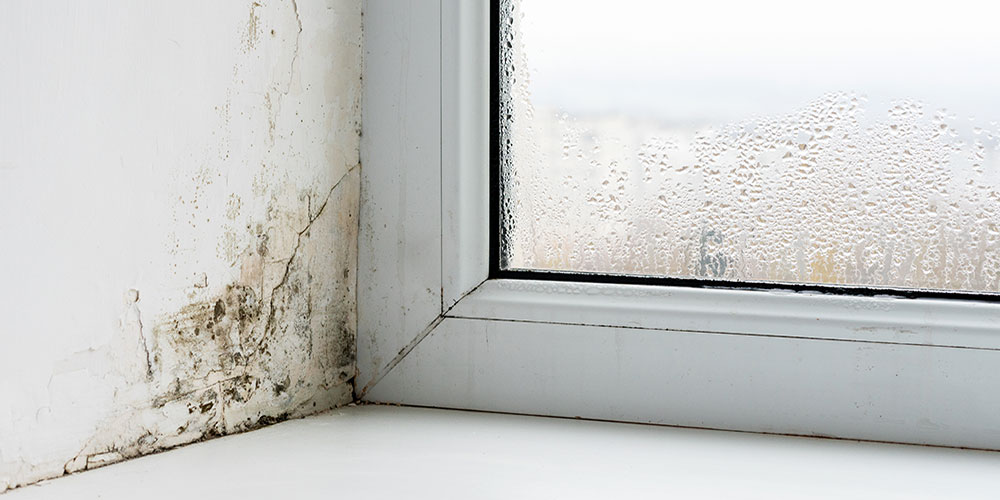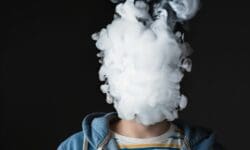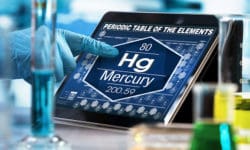Mold 101: What School and Healthcare Facility Pros Need to Know
Facility professionals need to understand the causes of mold growth, act fast when they detect an outbreak, and select the right tools to keep people safe during removal and remediation.

Photo: andrei310 - stock.adobe.com
When managing a hospital or school campus, facility professionals must keep a careful eye out for signs of a common but potentially disastrous problem: mold. Mold is an important part of the natural environment, but given the chance to grow indoors, it can wreak havoc on building materials, cause structural damage, and lead to health problems for people in the affected areas.
Within school buildings and classrooms, mold can trigger allergies and respiratory problems for students and staff alike. And mold poses an even greater health threat in hospital facilities. Patients with compromised immune systems are particularly vulnerable as mold exposure has been directly linked to healthcare-associated infections (HAIs) and even patient deaths.
To mitigate the risks, facility professionals need to understand the causes of mold growth, act fast when they detect an outbreak, and select the right tools to keep people safe during removal and remediation.
Moisture Accumulation Means Mold
Mold spores are often tracked indoors and attached to people’s shoes or clothing, and airborne spores come in through open windows, doors, and HVAC system vents. Once inside, mold can begin to grow in as little as 24 hours on damp surfaces—like ceiling tiles, wood, insulation, drywall, or carpet—and rapidly spread to other areas. Anywhere with organic material plus sufficient moisture is at risk.
Excessive moisture in campus buildings can come from many different sources. Unexpected events, like heavy rainstorms or burst pipes, can lead to indoor flooding. And maintenance issues, like a leaking roof or crack in a building’s foundation, can create standing water.
In other cases, excessive moisture may simply be caused by the building structure itself. Lack of proper humidity control and poor ventilation are particularly common in older buildings due to construction practices from the 1970s through the late 90s. Many buildings from this era are tightly sealed and unventilated, leading to years of condensation build-up and a surplus of moisture that gets absorbed and trapped by materials like drywall.
Given aging infrastructure problems across U.S. hospital systems and education systems, campus buildings are often the perfect breeding ground for mold growth.
Mold Remediation and Indoor Air Quality (IAQ) Concerns
When a suspected mold issue is found, facility professionals should work with a qualified mold assessor to evaluate potential mold growth using air samples and area swabs. The air samples will help determine the scope of the mold issue and what type of mold is present.
If remediation is required, there are several standards available for companies to follow:
- The Environmental Protection Agency’s (EPA) mold remediation guidelines for commercial buildings and schools
- The Institute of Inspection Cleaning and Restoration Certification (IICRC) standards for professional mold remediation companies. The IICRC S520 and R520 standards were created by microbiologists, scientists, health professionals, hygienists, contractors, and restoration service professionals
During the remediation process, it’s essential to mitigate the negative effects on indoor air quality (IAQ). Remediation may involve tearing down drywall, pulling up carpet, and even removing hardwood flooring—activities that can release harmful mold spores into the air. To remove mold safely and effectively, remediation professionals should use the proper protective equipment.
Of course, they need personal protective equipment (PPE) like respirators, gloves, and fitted goggles, combined with high-efficiency particulate absorbing (HEPA) filters, cleaners, wet vacuums, and disinfectants. However, PPE only protects the person wearing it. Remediation pros also need equipment to contain the affected area and prevent harmful airborne particulates from reaching people in adjacent areas of the building.
Best practices set by organizations like the IICRC involve two key products:
1. Reusable hard-sided containment barriers
Isolating the contaminated area involves closing off HVAC grills, sealing off cracks and crevices, and setting up containment barriers. Traditionally, remediation contractors have used one of two containment methods: either poly sheeting or hollowed-out drywall with insulation. However, both methods require expensive one-time-use materials and a lot of labor for setup. Plus, poly sheeting and drywall are not the most durable, clean, or visually appealing choices for busy environments like hospitals or schools.
Contractors and facility professionals are now turning to a better alternative that’s easy to install and can be used again and again: modular, hard-sided containment barriers. Temporary wall systems are quick and easy to install around a remediation area, and they can be configured to match the exact measurements needed to get the job done. In addition, the walls are durable, easy to sanitize, and aesthetically pleasing so active facilities can maintain a professional appearance throughout the remediation project.
2. Portable HEPA filtration systems
After isolating the contaminated area, contractors must establish negative air pressure to contain the airborne mold spores. Reusable containment walls can be paired with a HEPA air filtration system to achieve this.
Portable air scrubbers or negative air machines can draw in contaminated air from the sealed containment area. The air then passes through filters that remove particulates, like mold spores. This process creates a slight vacuum effect known as negative pressure, inside the containment area, preventing the spread of contaminants to other parts of the building.
There are several varieties of air filtration devices available on the market today, but the best choices are units equipped with true HEPA filters. These filters are a must for mold remediation. HEPA filters are manufactured, tested, certified, and labeled in accordance with filter standards. A true HEPA filter can capture 99.97% of 0.3-micron particulates, including mold spores, dust, and other allergens, and an even higher percentage of larger particles.
The Right Partner for Your Remediation Project
While it’s essential to use the proper remediation tools, it’s also important to have the right expertise in remediation best practices. That’s why many facility professionals and remediation contractors are choosing to work with experienced IAQ equipment providers who also serve as true partners. An experienced provider should not only guide you in selecting the right equipment but also be knowledgeable about industry standards and methodologies for effective remediation. This combination of technology and know-how will help you get the job done effectively while keeping everyone in your building safe from harm.
Linda Armendariz is the Rental Market Manager at Abatement Technologies. With over 25 years of experience in equipment supply, Linda leads the company’s strategic efforts in rental partnerships and assists businesses in selecting the right equipment for various projects.
Note: The views expressed by guest bloggers and contributors are those of the authors and do not necessarily represent the views of, and should not be attributed to, Campus Safety.
If you appreciated this article and want to receive more valuable industry content like this, click here to sign up for our FREE digital newsletters!
 Leading in Turbulent Times: Effective Campus Public Safety Leadership for the 21st Century
Leading in Turbulent Times: Effective Campus Public Safety Leadership for the 21st Century
This new webcast will discuss how campus public safety leaders can effectively incorporate Clery Act, Title IX, customer service, “helicopter” parents, emergency notification, town-gown relationships, brand management, Greek Life, student recruitment, faculty, and more into their roles and develop the necessary skills to successfully lead their departments. Register today to attend this free webcast!








Why not stop COVID-19 before it becomes an epidemic or quarantine situation?
ASIET Air Responds to Candida Auris Outbreak with Twenty-year-old Technology. ASIET has a scientifically proven process to kill Candida Auris from the air and on surfaces. See the White paper on our website http://www.justgoodcleanair.com
Air Scrubbers International Environmental Technologies or ASIET Air is an established provider of cutting-edge air purification solutions, addressing the urgent public health concern posed by Washington state or elsewhere.
ASIET will work equally well in reducing contamination on surfaces and air in meat processing facilities.
While others are trying to find a solution ours is ready to ship
Portable units can be in place in 24-48 hours nationwide
HVAC attached units are in stock also
American made in the USA
20 plus years of curing quarantine sick building with 100% success rate
An Outbreak of a deadly fungal infection, Candida Auris (C. auris) which has been steadily increasing throughout the United States in recent years, has been officially confirmed by CDC and authorities in Washington state. The fungal infection, known as Candida Auris, now poses a significant health risk to individuals, causing concern among residents and health officials alike due to its rapid spread throughout the air.
Officials in King County Washington, issued a statement on February 5th, 2024 revealing that an outbreak involving three patients infected with C. auris was identified at Kindred Hospital in Seattle, starting in mid-January. The statement noted, “These patients initially tested negative for C. auris upon admission, marking the first known outbreak of C. auris in Washington state.” Subsequently, another case was reported on January 26th at a nursing home in nearby Snohomish County.
The surge in C. auris cases, according to the agency, can be attributed to various factors, including inadequate practices regarding general infection prevention and control in healthcare facilities, as well as improved reporting and detection.
The CDC also noted that the mortality rate for severe infections is between 30% and 60%, but because it mainly affects individuals with compromised immune systems, it is considered rare by the CDC.
C.auris can be transmitted through direct contact with an infected person or by touching contaminated objects or surfaces. Previous research has indicated that the fungus can survive on surfaces and objects for at least two weeks.
John Lynch, from the University of Washington’s Harborview Medical Center in Seattle, explained to KIRO-7 TV that C auris is described as “an emerging pathogen, a relatively new infectious disease.” He added that it remains “challenging to diagnose Candida auris infection,” and that “people can carry it on their skin or in various parts of their body without causing any illness.” Laboratory testing is the only reliable method of confirming infection.
Individuals at heightened risk of infection include those with diabetes or blood cancer, recent surgical procedures, prolonged or frequent antibiotic use, extended stays in healthcare facilities or hospitals, and the use of central venous lines, breathing tubes, catheters, or similar medical devices.
ASIET for over twenty years has provided equipment for the Texas Department of Health with 17 cleared quarantines over these years. We are ready, willing and able to access and assist your needs.
References and whitepapers are available on request.